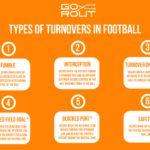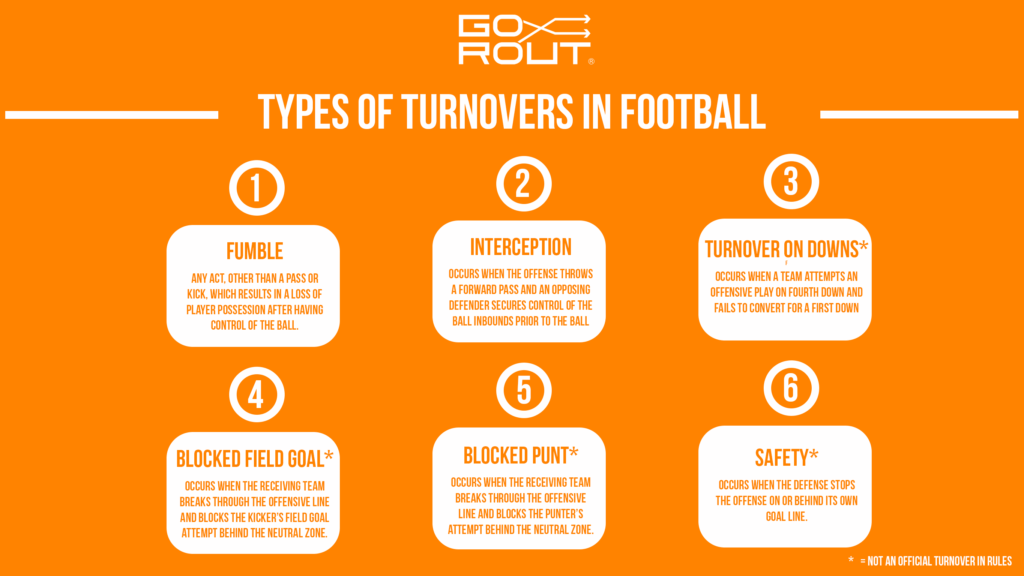13 Football Running Back Drills to Improve Ball Security and Speed
Reading Time: 9 minutes
Reading Time: 9 minutes
One of the most important aspects of being a successful running back is having excellent ball security and speed. Therefore, coaches must prioritize football running back drills to optimize their players’ performance.
In this article, we will explore 13 dynamic drills designed to give your players the edge they need to dominate the field.
We will also show you how to use GoRout, our football play calling system, to optimize your practice sessions and keep your players performing at a high level.
The Importance of Ball Security and Speed for Running Backs
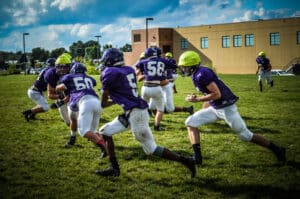
A running back’s ability to securely carry the ball and move swiftly can be the difference between gaining yards and losing possession.
Running backs must secure the ball during hand-offs and maintain it through contact. Ball security drills help maintain possession and drive the football down the field.
Speed allows running backs to burst through gaps and outrun defenders. Speed drills develop quick feet, explosive power, agility and endurance to find and exploit gaps in the defense.
Effective football conditioning programs include football running back drills for ball security and speed training. Running backs should be fast and maintain control of the ball at all times.
Key Components of Effective Running Back Drills

A football practice plan for running backs should include these key components to develop them into great players.
- Balance and stability: Running backs use balance and strength to maintain control and power throughout a rush. A good drill for ball carriers helps players stay upright and maneuver through tackles.
- Agility and quickness: It allows running backs to navigate through defenders and make sharp cuts on the field. Cone drills, ladder drills and shuttle runs enhance lateral movement and change-of-direction speed.
- Ball security: These drills prevent fumbles. They emphasize proper carrying techniques and simulate defensive attempts to strip the ball.
- Speed and explosiveness: A running back bursts through gaps and outruns defenders. Specific drills, such as sprints, hill runs and plyometric exercises build explosive power and acceleration.
Incorporate these key components into your football running back drills to emphasize ball security, improve footwork, and ensure strength and balance through contact.
5 Ball Security Drills for Running Backs
Ball security drills develop a running back’s control of the ball under high-pressure game conditions.
Drill 1: Ball Tuck and Hold
The Ball Tuck and Hold drill is a great ball security drill to teach running backs how to tuck the football into their body and maintain possession when under pressure. The ball carrier runs while keeping the ball close to its body and emphasizing the four points of contact – fingertips, palm, forearm, bicep and chest. The coach attempts to strip the ball away.
Benefits
- Improved ball security
- Enhanced awareness
- Strength and grip
Tips
Use the five contact points to maintain a secure grip on the football. The coach or teammates challenge players with attempts to strip the ball from a number of angles. Consistent practice with various drills is key to reinforcing muscle memory and enhancing ball security.
Drill 2: Gauntlet Drill

The Gauntlet Drill involves navigating a series of defenders attempting to strip the ball. Players start at one end of a line formed by teammates or coaches. They try to knock the ball loose as the running back progresses through the gauntlet. The key is maintaining possession and securing the ball under pressure from multiple directions.
Benefits
- Better ball security
- Enhanced agility and awareness
- Conditioning
Tips
Encourage the running back to keep the ball high and tight against their chest. The coach and teammates should vary the intensity and angles of their strip attempts. Provide immediate feedback on technique and encourage players to stay focused and alert throughout the drill.
Drill 3: Hop and Switch Drill
In the hop and switch drill, the ball carrier begins by standing in place with the football securely tucked. On command, they hop laterally to one side while maintaining control and proper hand placement on the ball. They then quickly switch directions and hop to the opposite side. The drill works rapid changes in direction while emphasizing ball security.
Benefits
- Improved balance and body control
- Reaction speed
- Ball security under movement
Tips
Keep the ball securely tucked throughout each movement. Maintain a low center of gravity and use quick, explosive hops to maximize agility and speed in changing directions. Start at a moderate pace and gradually increase speed as players become more comfortable with the drill. Add cones or defenders to simulate game-like conditions.
Drill 4: Shuffle and Switch Drill
Use this fast footwork drill for better lateral movement, footwork and ball security while changing direction. Players begin with the ball tucked securely under one arm and shuffle laterally across a set distance. At designated points, they switch the ball to the opposite arm while continuing to shuffle.
Benefits
- Improved lateral movement
- Coordination and timing
- Footwork precision
Tips
Keep the arms and shoulders low, knees bent and stay low to the ground for quick, controlled shuffles. Securely transfer the ball from one arm to the other. Ball carriers keep their eyes up and are aware of their surroundings. Gradually increase the pace of the drill when players are more comfortable and incorporate different shuffle distances.
Drill 5: Ball Security Drill
Ball security drills teach running backs to maintain a firm grip on the football. Ball carriers tuck the ball and run through obstacles like cones or agility bags. The coach or teammates simulate defenders by attempting to get the ball away at different points. This drill reinforces proper ball-handling techniques under pressure.
Benefits
- Better ball protection
- Strengthens grip
- Simulates game conditions
Tips
A running back’s arms must be high and tight against their body while holding the ball. Vary the intensity and angles of attempts to strip the ball to replicate different defenses. Highlighting areas for improvement. Adjust the complexity of the obstacle course and defender tactics as players advance for continuous development.
5 Agility and Quickness Football Running Back Drills

Agility and quickness drills teach running backs to evade defenders and accelerate through gaps.
Drill 1: Jump Cut Drill
The Jump Cut Drill improves a running back’s ability to quickly change direction while maintaining balance and control of the football. Players begin by running straight ahead and, on command, perform a quick jump cut to the left or right, simulating a defender’s evasion. This drill emphasizes quick lateral movement, agility, and ball security as players navigate through cones or markers.
Benefits
- Agility
- Explosive power
- Improved reaction time
Tips
Keep the football tightly tucked against the body throughout the drill. Incorporate verbal or visual cues to signal the direction of the cut for quick reactions. Stay consistent when practicing this drill to help running backs improve their agility, balance and ball security.
Drill 2: Line Response Drill
The Line Response Drill improves response time to defensive interference. Players line up with the football and sprint towards a designated line marked on the field. The coach signals a direction change as they approach. The player must cut left, right or spin to avoid a defensive player.
Benefits
- Quick decision-making
- Ball control under pressure
- Coordination
Tips
The ball carrier keeps their eyes up and scans the field to anticipate the coach’s signals. When finished with one foot, repeat this drill using the other foot. Emphasize a low center of gravity and quick, controlled movements. At the end of the drill, have the player sprint forward or at an angle to practice speed.
Drill 3: Ladder Drills
Lay an agility ladder flat to quicken a player’s feet. Perform various footwork drill patterns through the ladder, such as high knees, two feet in each hole, two steps, lateral shuffles and in-and-out movements. These drills require efficient footwork and rapid movement through the ladder.
Benefits
- Superior footwork
- Increased speed
- Better coordination and balance
Tips
Ladder drills are great football running back drills for all levels. Have a consistent rhythm, and stay light on your feet. Use the balls of your feet for quick, precise movements. Keep the upper body relaxed but engaged. Perform drills at a high intensity.
Drill 4: Cone Drills
Football coaching gear – like cones – creates various patterns that running backs must navigate. Players alternate and weave through cones, perform quick cuts and sprint between markers in an open field. Common cone drills include the “zig-zag,” “figure-eight”, and “T-drill”.
Benefits
- Spatial awareness
- Stronger footwork
- Conditioning and endurance
Tips
Set up cones in patterns to challenge different aspects of agility and footwork. Encourage players to be aware of their surroundings while making sharp cuts. Each direction change should be explosive. Keep the drill short with adequate rest in between.
Drill 5: Hop Over Cones Drill
This drill challenges a running back’s explosiveness, agility and balance by having players perform controlled hops over a series of cones. Players start on one side of the cones and hop laterally or forward over each cone holding the football.
Benefits
- Explosive Power
- Balance and stability
- Core strength
Tips
The cones should be in a straight line with equal spacing between them. Focus on soft landings and balance. Use a low center of gravity and quick, controlled hops. Start with a moderate pace and gradually increase speed.
3 Speed and Explosiveness Football Running Back Drills
Speed and explosiveness drills in football practice script boost acceleration and power for running backs.
Drill 1: Sprints and Resistance Runs
The running back does short sprints and resistance runs with a resistance harness or resistance bands. The sprints are typically 10-20 yards and practice explosive acceleration. Resistance runs strengthen the muscles used for sprinting.
Benefits
- Speed development
- Strength building
- Endurance
Tips
Focus on driving the knees and maintaining a forward lean for power and speed. Gradually increase the resistance level as your strength improves. Start with a manageable level of resistance for proper technique. Get rest between sets to prevent fatigue-induced injuries. Use a hill as a level of resistance if you don’t have bands or a partner.
Drill 2: High Knee Bag Drill
In the high knee bags drill, the running back lifts their knees high while moving over a series of bags placed in a line or grid pattern. The aim is to lift each knee high enough to clear the bags without touching them with rapid foot turnover and proper running form.
Benefits
- Strengthens lower body
- Cardiovascular endurance
- Coordination and timing
Tips
Lift your knees high and drive your arms in a controlled manner. It will help momentum and speed. Use the bags for accuracy and rhythm. Keep your eyes up while running through the bags.
Drill 3: Plyometric Drills
Plyometric football running back drills involve jumping, bounding and quick directional changes. These drills include box jumps, depth jumps and lateral bounds for better power, speed, body control and agility.
Benefits
- Injury prevention
- Body control
- Mental toughness
Tips
Warm up before starting plyometric drills to prepare your muscles. Begin with low-intensity variations of each exercise. Focus on quality over quantity so each repetition is performed with proper form and maximum effort. Prioritize safety and technique to minimize the risk of injury.
How to Use GoRout in Football Practice
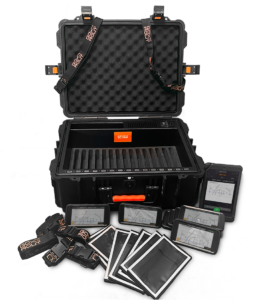
Sports coaching technology helps a football coach streamline practices, strengthen player skills and prepare the team for victory on the field.
The GoRout coach to player communication system revolutionizes how coaches, players and teams execute practice time. GoRout allows coaches to create and organize a football practice plan using a web scripting app. With a mobile app, they can instantly send play cards to the players’ wearable devices, eliminating the need for huddles and reducing miscommunication.
GoRout equipment stands the test of time and is a breeze to set up without WiFi or complex configurations.
Simplified scripting

Our scripting platform integrates with any card drawing software to add or edit scripts and cards easily. Seamlessly copy or move plays from half to half for well-structured practice sessions.
Experience GoRout practice to see how your team can boost communication, reps and wins!
Coaches app
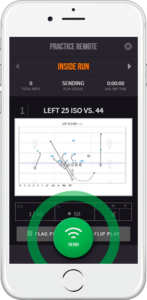
The on-field practice app streamlines information using GoRout STEEL technology for quick and easy communication with players. Instantly flip formations on your phone, flag plays for review with a single touch and edit cards in real-time using the finger drawing tool.
Player device
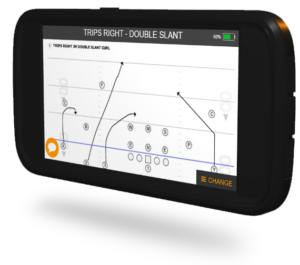
The GoRout football practice device resists the rigors of practice while providing real-time feedback and communication. Players receive detailed instructions and play diagrams directly on their wearable devices to see and execute plays quickly. Practice time becomes more efficient when players spend less time in huddles and more time running plays.
GoRout testimonials come from high school, college and youth football coaches around the country, testifying to how GoRout has helped them improve practices and win games.
Get a quote and receive pro tips to improve your football practices at any level of play.
Final Words About Football Running Back Drills
Football running back drills help develop vital skills such as agility, speed, and ball handling.
Incorporate these 13 football running back drills into your practice regimen to improve footwork, boost explosiveness, and improve ball control.
For improved results, consider implementing GoRout into your practice sessions. Our system supplements football drills and improves your team’s preparedness for game day.
Get a quote now.
FAQs About Football Running Back Drills
How can I be a better running back in football?
To be a better running back, get in shape and improve flexibility. Practice quickness and agility drills and build strength in your legs and core.
What are the 3 main responsibilities of a running back in football?
Running backs receive handoffs, line up as receivers to catch passes, and block.

